Racing To Win With Sir Ben Ainslie
Book Extract
It is easy to make assumptions about winning but after much experience of racing Lasers the most successful are those who make the fewest mistakes, are able to pull something out of the bag when they need it and are the most consistent.
These days nearly all events are of twelve races or more, so this really puts the emphasis on consistency. Think of a series as a structure; you need some solid results in the early races to give you a good foundation to work from.
As soon as you become inconsistent you are in trouble; it is the uncertainty which ruins your confidence leading to erratic decision-making and probably just as erratic results.
Psychology
I remember when I was in the Youth Squad, every year Jim Saltonstall would have evening lectures, which were great, but every now and then there would be a lecture on psychology. At the age of seventeen once psychology was mentioned I was off in a dream world and anyway ‘I could just hike harder if I had a problem’.
I now know that psychology is the key to everything, in life and sport. What is going through your mind will affect how hard you train, how determined you are, your ability to deal with pressure, how you get on with your fellow competitors and your enjoyment of racing.
If you want to get to the top of the Laser fleet, then you have to be totally committed. The days of training at the weekend and summer holidays have gone. It has to be your job, hobby, life.
I can say with some conviction that the reason people like Robert Scheidt and myself have been successful is that we put in more effort than most sailors. I remember one very good example of this was just before the’96 Olympics in Savannah. There was a warm-up regatta at Hilton Head, which is about 25 miles further down the coast. Robert and I sailed down there while the rest of the fleet either got their boats towed or driven to Hilton Head. We were lucky that it was a downwind sail on the way and when I sailed back it was also downwind but this meant very valuable time sailing in the strange and confused waves off Savannah and it paid off.
When you get out on the water you need to leave behind anything in your mind which is not connected to winning the race or sailing well. Forget about problems with your girlfriend, bank manager or whoever – your mind needs to be totally focused on the job in hand. Try not to get too involved with the social side – again it depends how serious you want to be, but the more time spent chatting will drag your focus away from the racing.
You’ll notice that the really top sailors are normally the most modest, the reason being that they know they are good, so they don’t need to tell everyone about it. If you hear someone blowing their own trumpet about a great start or something, just ignore it and go through your own mental debrief of the race. This is really important as it enables you to pick out where you went wrong, areas you need to improve and the positives. You also don’t get put off by the guy telling you that the only reason you pulled off that great port tack start was because he had to bear away for you and by the way you owe him a few beers.
The more you go through the racing mentally the better prepared you will be for the next race. I really enjoy watching videos of sailing races, in any class of boat. Not only is it fun watching a good video but it is a form of mental rehearsal where you can also pick up tips from the racing.
At most regattas there are times when you will be held ashore due to a lack of or too much wind. All the hanging around can be really frustrating, boredom sets in and you lose all interest in going sailing or alternatively you get really wound up as you are dying to get out on the water and go racing.
Try to have a plan for these situations which will give you something to do while not totally distracting you from getting ready to race. A bit of a kick around can be good fun (but make sure it doesn’t get too aggressive) or try reading a book or playing a computer game.
When you hit the water, you want to be ready. The very nature of the Laser class means that the racing is very close and there are times when you will need to be very aggressive. You cannot afford to give an inch to anyone at any time. So be mentally prepared for some tough racing out there.

If you want to get to the top you have to be totally committed
THE RACE
Pre-Start
If you have a training partner, then use each other before the start. At some stage you should split tacks, going for five minutes and then tacking back. This may help you to figure out which side of the course is favoured but make sure that the wind is not just oscillating, in which case both sides may be favoured.
It is good to have a routine for the pre-start so that you are not sailing around wondering what to do next. Before the warning signal goes you need to have passed any extra clothes and food to a coach boat. You also need to have come up with a plan for the race.
The plan should be based on the weather forecast, what you have learnt by sailing up the course both on previous days and on your earlier training run and the sailors you are racing against and trying to beat.
If it is the last race of a regatta and there are only two of you in it, you may want to stick with the competition rather than risk separating from them too much.
Also, if the conditions are those in which you know you are weak then you may need to try to push the start harder and also be more confident in splitting from the rest of the fleet.
Once the warning signal has gone you should be ready on your watch. Most events run the system 5, 4, 1, start, so you should have no problem in getting the 4-minute signal.
You should now be trying to work out the line bias and there are a number of ways to do this. If you have a compass, then use it to get a bearing of the startline and also the wind direction. If the wind direction is more than 90° to the startline bearing then the starboard end of the line is favoured by however many degrees over 90 the difference is, and vice-versa.
For example: Wind 200°, Startline 100°. Square line = wind direction of 190°. So the line is biased 10° to the starboard end.
The easiest methods are either to sail head-to-wind on the startline and then judge which end of the line your bow is pointing towards, or sail close-hauled away from both the starboard and port ends of the line and judge which end feels and looks better.
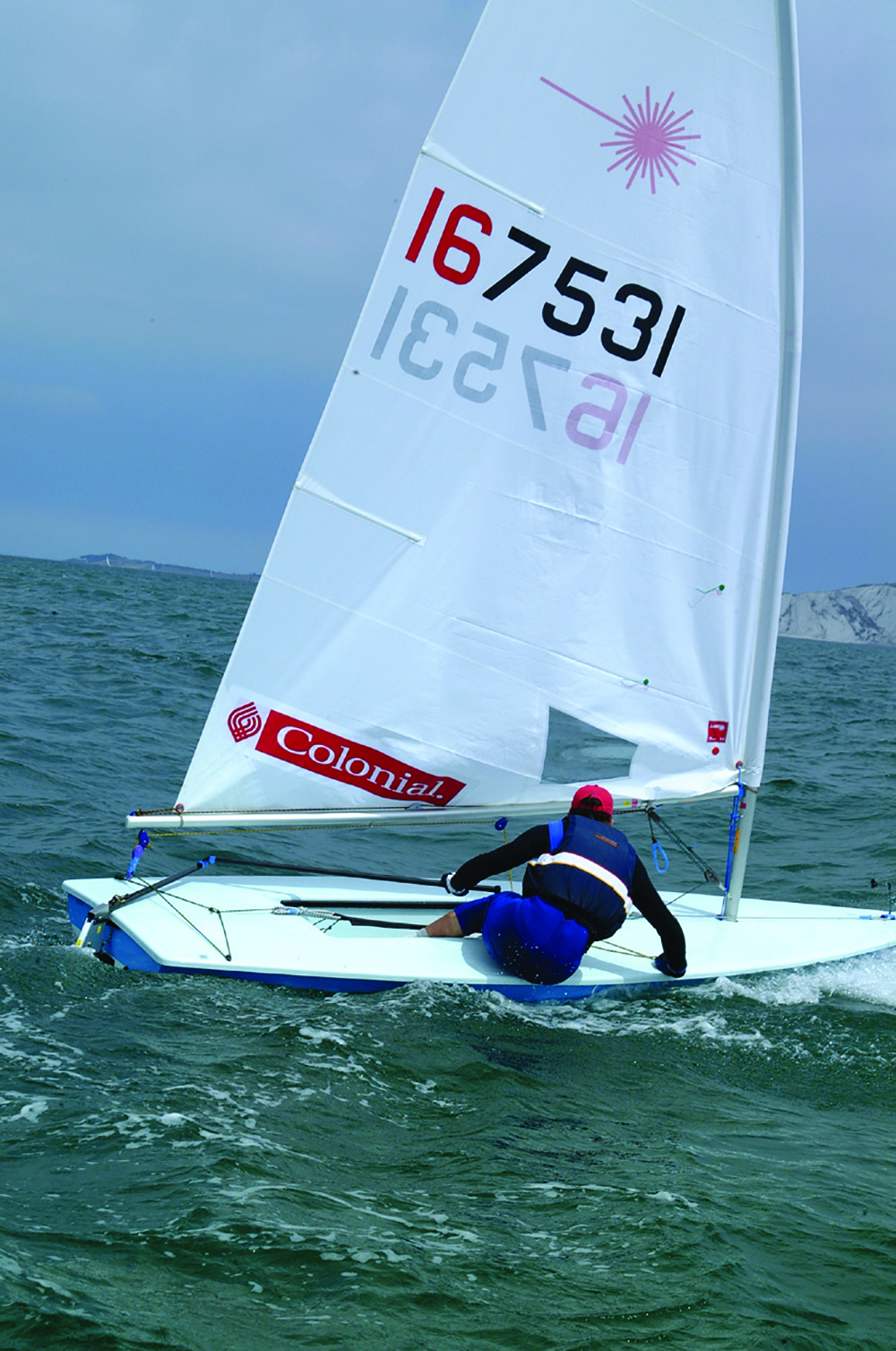
Go head-to-wind on the line to judge the bias
Bear in mind that what looks the favoured end of the line may not be. If, for instance, the wind is oscillating, in a couple of minutes you may have 10-20° windshift, or a rough sea may make one tack much quicker than the other and this will also affect which end of the line is favoured.
Your plan for the first beat may require you to start at the unfavoured end of the line but if you are really confident the side you want will pay then go for it (but you will need to make these decisions very quickly).
Try not to make your plan look too obvious, for example, if you are planning to try to port tack the fleet don’t sit by the pin end boat on port as the rest of the fleet will catch on and try to stop you. Leave your approach as late as possible.
Starting
Fleet sizes are normally large and so the start line is crowded. Lasers are relatively quick to accelerate so most boats are normally close to the line jostling for position very early in the starting sequence, unlike many other classes which tend to line up further back from the line to have plenty of time to accelerate.
The rules allow you to move your tiller to steer the boat, but you are not allowed to constantly move your tiller from side to side to propel the boat forwards. Therefore, you need to work on a technique of using your tiller on one side of the boat’s centreline and then after a while use the tiller on the opposite side of the boat to turn back. This should help to hold you in position without breaking the rules.

Waggle the tiller either side to stay head to wind
You should try to have a good awareness for the positioning of the judge boats: if you know you are being watched then you may be doing something wrong, so be careful.
Being able to handle the boat well in pre-start manoeuvring will only come with practice but this is something which you can do on your own.
The key to starting well in any boat is to be that split second ahead of the boats around you so that you are the first boat up to full speed and pop out ahead after the starting signal has gone. If you try to start ahead of the other boats around you, then unless you are very sure of the where the line is, you are vulnerable to starting early.
Accelerating Off The Line
To accelerate quickly you need to have at least a boat length of space to leeward to bear off into and gain speed. Don’t go into a gap on the line too early and then start creating too much space to leeward as it will be too inviting for another boat to go in there and steal your spot.
As soon as you feel it is time to go or the boats around you sheet in then you have got to go for it. Try to give the boat enough time to build speed before you head up to close hauled; this is why you need plenty of space to leeward.
You really need to practise accelerating, and in particular, getting the mainsail in as quickly as possible. If it is windy then the vang tension is really crucial. If the vang is too tight you will find the boat very hard to manoeuvre and if too loose you will not have enough drive in the sail to help you accelerate.
The First 100 Metres
As you come off the line try to keep as much speed as possible without being affected by the other boats. If you have a good start then try to punish those around you as much as possible by either sailing higher and so lee bowing those to weather or easing for speed and rolling over the top of the guys to leeward. Doing this will give you more options to tack or hold your lane.
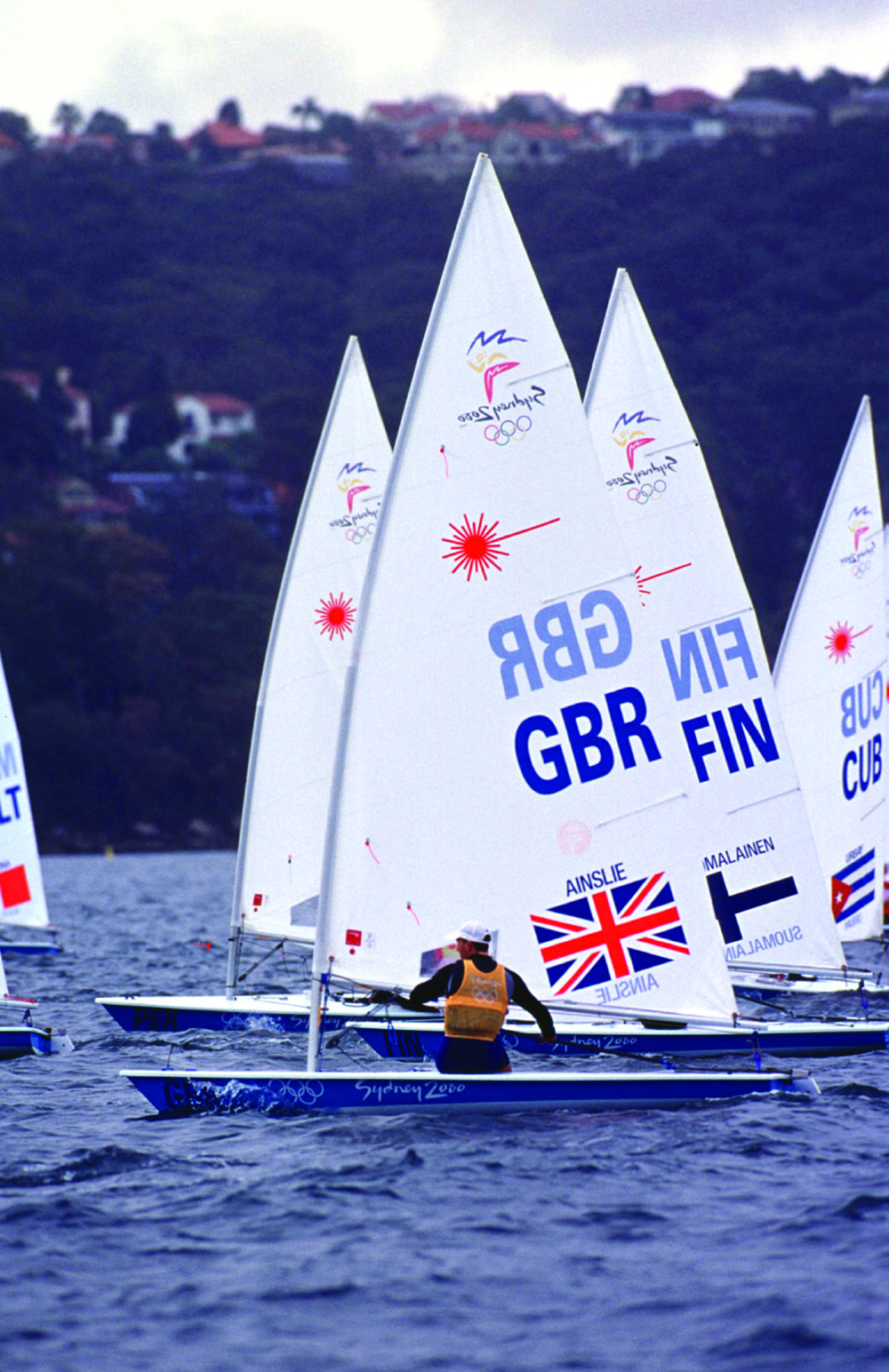
As you come off the line try to keep as much speed as possible
If you have a poor start, then look to clear your air but don’t be too hasty. Lasers are not as badly affected by sailing in dirty air as other boats. In fact, if you can sail on the boat ahead’s stern wake you can actually hold on to that boat. Wait for an opportune moment to tack away and then peel off. Don’t give up, you still have plenty of opportunities to catch up.
While it is important to work the boat really hard off the line be conscious of the jury. It is at the start that the jury are most observant, so be careful.
Which Way Up The First Beat?
If you can find some extra boatspeed off the start line and up the first beat, then it will make life a lot easier. The saying that ‘boatspeed makes you a tactical genius’ is not far off the mark.
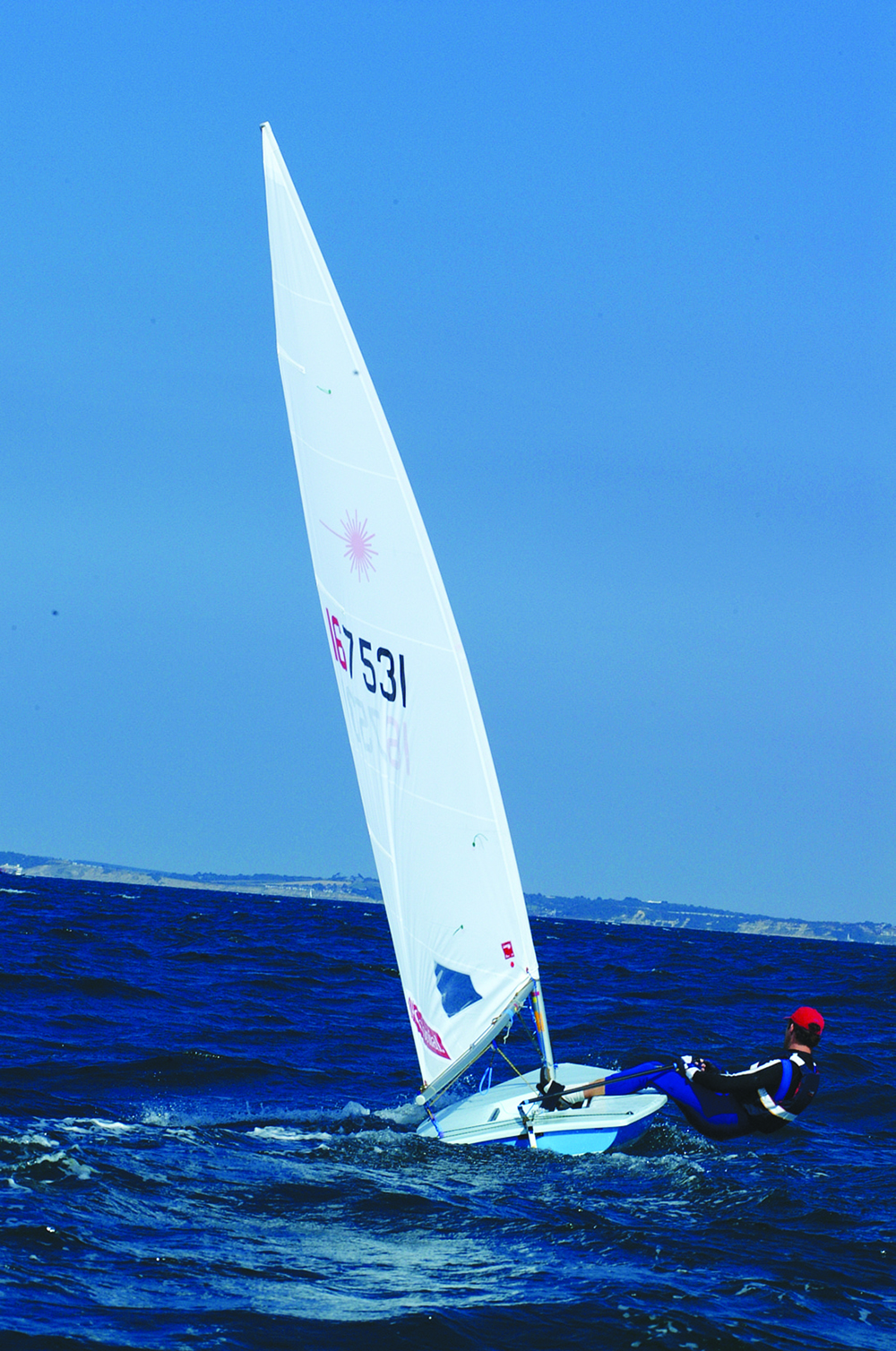
Keep the boat upright up the beat
As I said I have never used a compass as I find that using the angles of my competitors is just as good a guide to the wind and with the generally short courses which we now race on it is as much a percentage game as anything else. It is a case of getting in a good position and then trying to preserve that position by keeping between the majority of the fleet and the next mark.
There will always be people who hit the corners and come screaming in with a great lead but if you can always sneak ahead of the main pack then you will be able to get to the windward mark in consistently good shape. I’m not saying that if you really have a feeling that one side is going to pay you shouldn’t go for it.
If you feel you are losing ground on the boats around you then you are either not in phase with the windshifts or don’t have the right boat set-up and are going slowly. You need to be able to realise quickly why you are losing ground and rectify the problem.
Windward Mark
Most windward marks are hot spots for incidents and protests. There is also the prospect of gaining or losing a large number of places.
If you are in a good position at the front of the fleet then give yourself enough time to prepare for the bear away while not getting onto the starboard layline too early, because the further from the mark you are the harder it is to hit the layline smack on.
If you are struggling in mid-fleet then the approach to the windward mark is more interesting. If you are going to get on the starboard layline early then make sure you overstand slightly; if you don’t then boats in front will tack on your wind and you’ll find you have to keep tacking away for clear air. It can often pay to stay away from the starboard layline and all the bad air which comes from it and arrive at the mark on port.
Remember that if you tack within three lengths of the mark you are very vulnerable under the rules. Also, approaching the windward mark on the port layline will cause you to have to sail through all the boats that are on the first reach or run, which is slow and hazardous.
If you can try to predict what might happen as you approach the mark it will really help in your decision making, rather than screaming in and then suddenly realising you’ve got nowhere to go.
If you see most of the fleet stacking up on the starboard layline then there is definitely the opportunity of gaining by not getting stuck in all that bad air too early. There are often big pile-ups at the windward mark as there are at the leeward marks.
My advice is that, even if you are in the right, it normally saves you a lot of time if you steer clear of trouble. The last thing you want is another boat sailing through your mainsheet and capsizing you.
Again, it is a case of thinking ahead and predicting where there may be trouble.
Reaching
I always used to think there was little chance of gaining much ground on the reaches, but Mark Littlejohn taught me otherwise. If you have good speed, then there are always opportunities to make big gains.

If you have good reaching speed there are always opportunities to make big gains
When you begin the reach, you have to assess the situation immediately. If you see the boats in front of you sail high, then your likely gains will come from sailing low and vice-versa.
It also helps to know your competition’s strengths and weaknesses. If the sailor in front is the type who will never let you sail over the top of them, then you know you will have to try to draw them high of the rhumb line and then try to dive beneath them.
Not only do you need to be fast, but you need to be flexible in sailing large angles for a reaching leg. There will be times when you will have to sail far higher than the proper course to the next mark in order to get around a fleet of boats. It is the sailors who are able to sail fast at any angle and be aggressive enough to go for the overtaking manoeuvres who make the biggest gains.
There are a few definite rules for reaching. Firstly, on very tight reaches it hardly ever pays to sail low. The bad air of the surrounding boats is that much worse when sailing closer to the wind and you are also limited in your ability to accelerate as sailing any higher than the proper course will normally slow you down, especially in strong winds.
The biggest gains are normally made by making an initial loss to get higher than the rest of the fleet and then trying to blast down over the top of the boats ahead; it’s hard work but you can still make some good gains.
Also try not to get forced into sailing high by the boats behind you. If you are confident in your speed, then hold your course; unless the boats astern begin to affect your air you will end up gaining.
If it is a reach to the finish line, then you may have more options to sail low. Try to establish as early as possible which end of the finish line is favoured – the boats ahead may be a good reference for this. Too many sailors stop trying on this leg as they feel the race is already over, so here’s your chance.
Running
Again, even before you get to the windward mark, try to establish which way you want to go down the run. This may also be determined by which way the boats in front are going.
The most important factor is to be sailing in clear air. It is very hard to just sail through a group of boats, although it can be done. It is far easier to sail around the groups in clear air and clean waves.
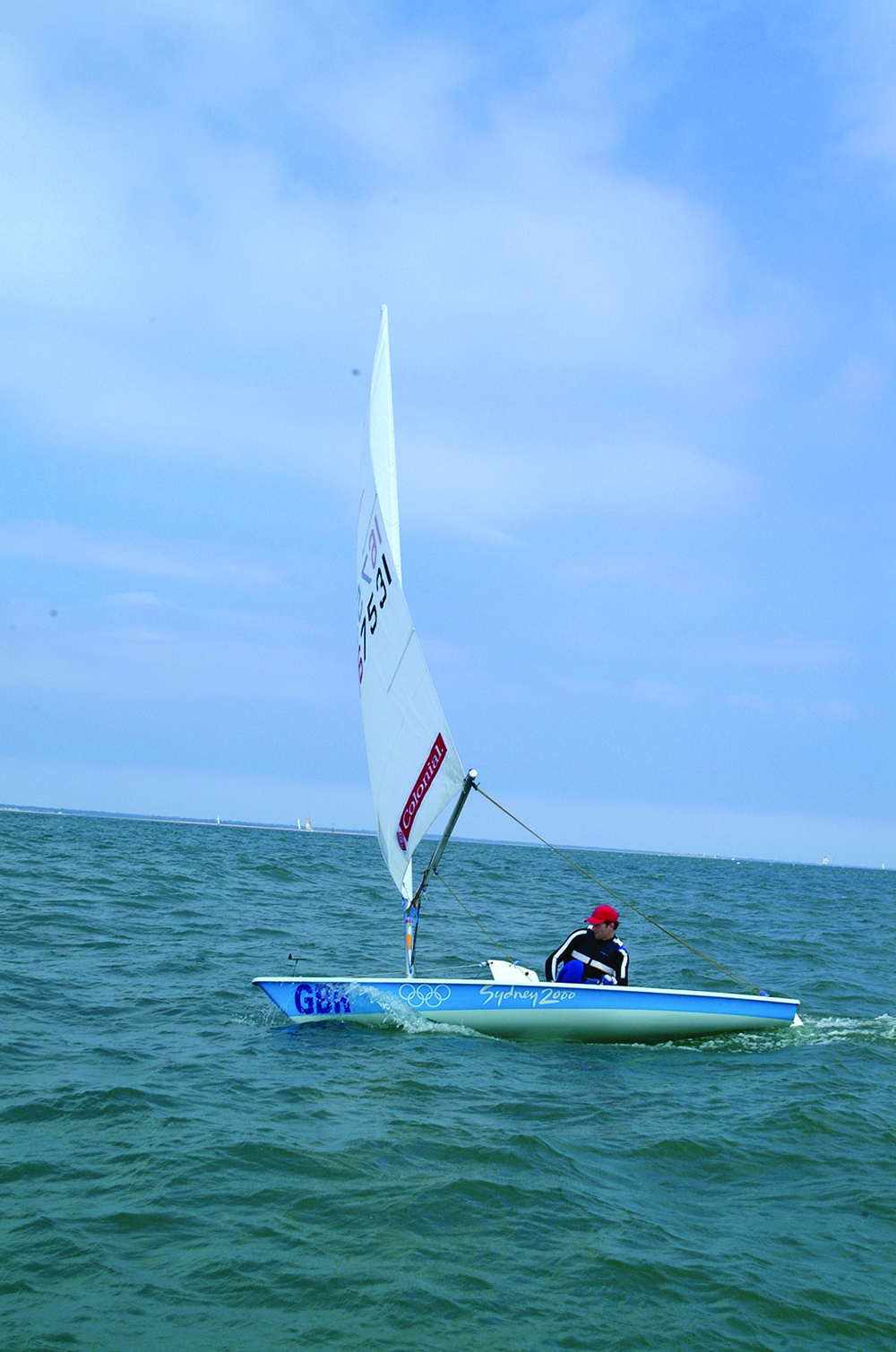
When running – Cunningham off, vang and outhaul loose
If you have a good lead or have few boats around you then your options are open: sail the quickest course possible.
When a large group of boats is right behind snapping at your heels then you will have to take one side of the run or the other in order to keep clear air.
There are also times when you are mid-fleet that you come around the mark to find that the fleet has split to both sides of the run and in fact there is a clear lane straight down the middle. This can often be a great way to make huge gains.
Like reaching, those who make the biggest gains are often the most extreme, e.g. by sailing ridiculously large angles and extra distance in search of better wind and waves. The gains are often larger than those made on the upwind legs.
Gybe Marks & Leeward Gates
As you approach the gybe mark consider whether you want to go high or low on the next reach. If the next leg is a run, then decide if you want to go left, right or down the middle. You will then need to set yourself up so that immediately after the gybe mark you are able to sail the course you want. Don’t get caught out by other boats determining where you end up sailing.
The leeward gate is always quite an exciting part of the race. It is good to have a rough idea of which mark you are going to as you approach. This will be based upon which mark is closest to you, which way you want to go up the next beat and also which mark has fewer boats rounding it. However, you still need to be open minded as you approach the gate, watching the boats in front of you. A gap may appear where a boat in front peeled off for the other mark at the last minute.
If you are mid-fleet the chances are that you will need to tack away after rounding to clear your air. In which case if you were wanting to head right up the beat then you may actually save two tacks by going around the right-hand gate (as you look downwind).
Consolidation
Every point gained or lost is vital and you must fight for every place as in the end it will make the difference.
At the Youth World Championships in 1994 Daniel Slater and I were very close on points throughout the regatta and the final race was desperately close. I won and Dan was 4th. The final result was that Dan won the championship. We had finished on equal points, but Dan’s discard was one place better than mine. Of course, I was devastated at the time but it taught me an invaluable lesson. However badly you are doing in a race and whatever might have happened, whether it was your fault or not, you must never give up, every race counts.
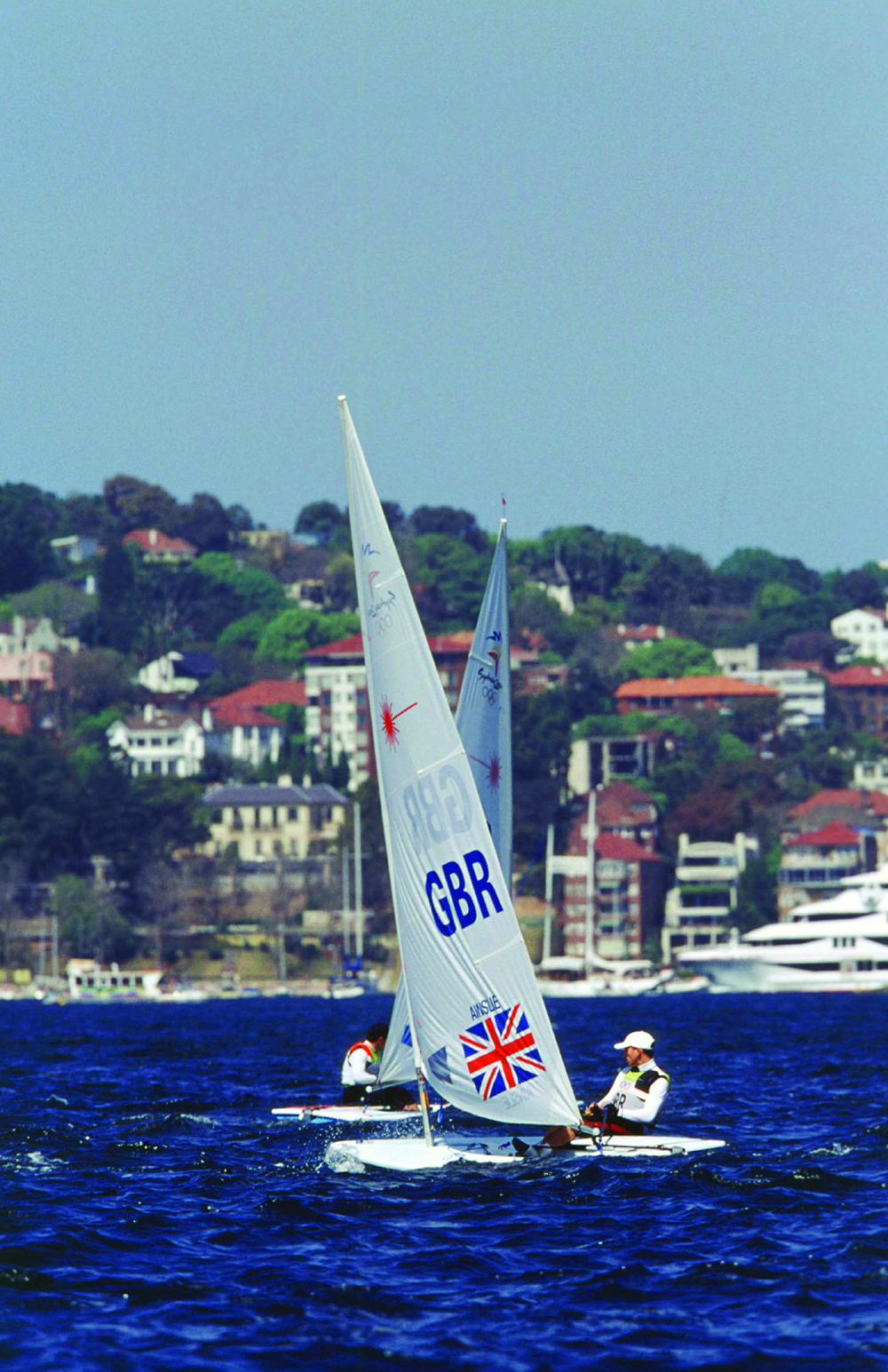
Never give up, every race counts
In the end all of those places gained by giving everything until you have crossed the finish line will be the difference between being a winner or not. And I want you to be a winner.
© Not to be reproduced without written permission from Fernhurst Books Limited.
The Laser Campaign Manual is written by the world’s most successful Olympic sailor and is the book he wrote after winning his first gold medal. Sir Ben Ainslie’s Laser Campaign Manual was re-published in 2020 as a special 20th Anniversary edition of winning that gold in the Laser in Sydney.